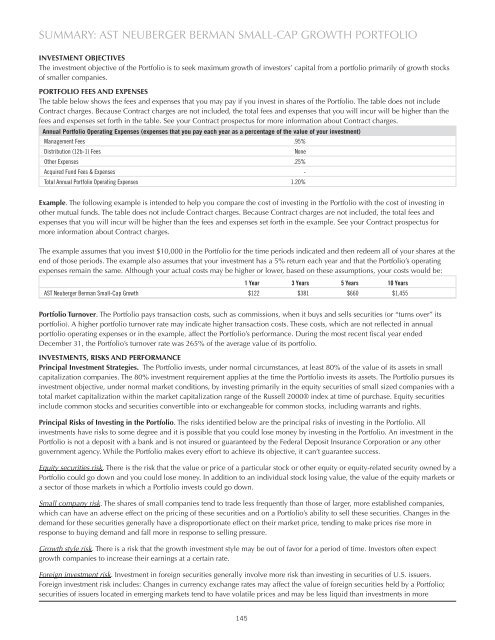Advanced Series Trust AST Academic Strategies Asset ... - Prudential
Advanced Series Trust AST Academic Strategies Asset ... - Prudential
Advanced Series Trust AST Academic Strategies Asset ... - Prudential
Create successful ePaper yourself
Turn your PDF publications into a flip-book with our unique Google optimized e-Paper software.
SUMMARY: <strong>AST</strong> NEUBERGER BERMAN SMALL-CAP GROWTH PORTFOLIO<br />
INVESTMENT OBJECTIVES<br />
The investment objective of the Portfolio is to seek maximum growth of investors’ capital from a portfolio primarily of growth stocks<br />
of smaller companies.<br />
PORTFOLIO FEES AND EXPENSES<br />
The table below shows the fees and expenses that you may pay if you invest in shares of the Portfolio. The table does not include<br />
Contract charges. Because Contract charges are not included, the total fees and expenses that you will incur will be higher than the<br />
fees and expenses set forth in the table. See your Contract prospectus for more information about Contract charges.<br />
Annual Portfolio Operating Expenses (expenses that you pay each year as a percentage of the value of your investment)<br />
Management Fees .95%<br />
Distribution (12b-1) Fees<br />
Other Expenses .25%<br />
Acquired Fund Fees & Expenses -<br />
Total Annual Portfolio Operating Expenses 1.20%<br />
None<br />
Example. The following example is intended to help you compare the cost of investing in the Portfolio with the cost of investing in<br />
other mutual funds. The table does not include Contract charges. Because Contract charges are not included, the total fees and<br />
expenses that you will incur will be higher than the fees and expenses set forth in the example. See your Contract prospectus for<br />
more information about Contract charges.<br />
The example assumes that you invest $10,000 in the Portfolio for the time periods indicated and then redeem all of your shares at the<br />
end of those periods. The example also assumes that your investment has a 5% return each year and that the Portfolio’s operating<br />
expenses remain the same. Although your actual costs may be higher or lower, based on these assumptions, your costs would be:<br />
1 Year 3 Years 5 Years 10 Years<br />
<strong>AST</strong> Neuberger Berman Small-Cap Growth $122 $381 $660 $1,455<br />
Portfolio Turnover. The Portfolio pays transaction costs, such as commissions, when it buys and sells securities (or “turns over” its<br />
portfolio). A higher portfolio turnover rate may indicate higher transaction costs. These costs, which are not reflected in annual<br />
portfolio operating expenses or in the example, affect the Portfolio’s performance. During the most recent fiscal year ended<br />
December 31, the Portfolio’s turnover rate was 265% of the average value of its portfolio.<br />
INVESTMENTS, RISKS AND PERFORMANCE<br />
Principal Investment <strong>Strategies</strong>. The Portfolio invests, under normal circumstances, at least 80% of the value of its assets in small<br />
capitalization companies. The 80% investment requirement applies at the time the Portfolio invests its assets. The Portfolio pursues its<br />
investment objective, under normal market conditions, by investing primarily in the equity securities of small sized companies with a<br />
total market capitalization within the market capitalization range of the Russell 2000® index at time of purchase. Equity securities<br />
include common stocks and securities convertible into or exchangeable for common stocks, including warrants and rights.<br />
Principal Risks of Investing in the Portfolio. The risks identified below are the principal risks of investing in the Portfolio. All<br />
investments have risks to some degree and it is possible that you could lose money by investing in the Portfolio. An investment in the<br />
Portfolio is not a deposit with a bank and is not insured or guaranteed by the Federal Deposit Insurance Corporation or any other<br />
government agency. While the Portfolio makes every effort to achieve its objective, it can’t guarantee success.<br />
Equity securities risk. There is the risk that the value or price of a particular stock or other equity or equity-related security owned by a<br />
Portfolio could go down and you could lose money. In addition to an individual stock losing value, the value of the equity markets or<br />
a sector of those markets in which a Portfolio invests could go down.<br />
Small company risk. The shares of small companies tend to trade less frequently than those of larger, more established companies,<br />
which can have an adverse effect on the pricing of these securities and on a Portfolio’s ability to sell these securities. Changes in the<br />
demand for these securities generally have a disproportionate effect on their market price, tending to make prices rise more in<br />
response to buying demand and fall more in response to selling pressure.<br />
Growth style risk. There is a risk that the growth investment style may be out of favor for a period of time. Investors often expect<br />
growth companies to increase their earnings at a certain rate.<br />
Foreign investment risk. Investment in foreign securities generally involve more risk than investing in securities of U.S. issuers.<br />
Foreign investment risk includes: Changes in currency exchange rates may affect the value of foreign securities held by a Portfolio;<br />
securities of issuers located in emerging markets tend to have volatile prices and may be less liquid than investments in more<br />
145

















